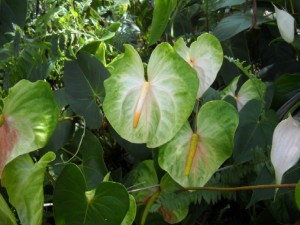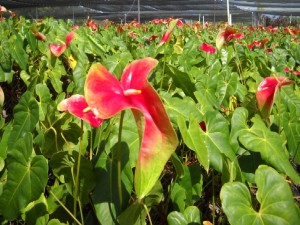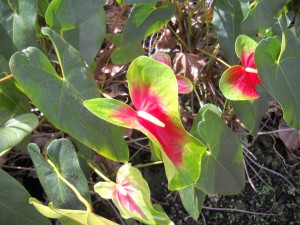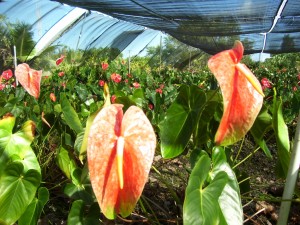Mauna Loa Anthurium
Mauna Loa Anthurium Flowers are obake anthuriums that are white and green. They tend to be white in the center and green at the edges. Mature plants can produce extra large flowers.
Ancestry of the Mauna Loa
The Mauna Loa’s mother plant was a Tropic Ice, but we don’t know who the father anthurium plant was as the Tropic Ice was open pollinated. What this means is that the pollination didn’t occur under controlled conditions, so no one knows exactly which plant produced the pollen that fertilized the Tropic Ice and fathered in the Mauna Loa.
It is a great variety for growers because it is blight tolerant and anthracnose resistant and it is also a favorite of people who like cut flowers as it can last up to 56 days in a vase when freshly cut. And even after being dry packed for three days it can still last 39 days in a vase.
How the Mauna Loa Anthurium Got Its Name
The Mauna Loa Anthurium was named after Mauna Loa, which is the second tallest of the five volcanoes that make up the Big Island. It is also the largest volcano in the world when measured by volume. Translated from Hawaiian to English, its name means “Long Mountain.” It is an active volcano that last erupted in 1984. The city of Hilo, which is the most populated city on the Big Island, is built upon its slopes, so any eruption of Mauna Loa poses great danger to the city.
Kalapana Anthurium
Kalapana was a beautiful black sand beach in Hawaii that was known for its pounding surf and huge coconut trees. I say “was” because it no longer exists. Kalapana was consumed by fiery lava after the Kilauea volcano began erupting back in the eighties.
I suspect Kalapana obake anthurium flowers were named after this beach that was consumed by fire. Perhaps because they come in a fiery shade of red that might symbolize lava and they are tinged with green that might symbolize the coconut trees that used to grace this amazing beach that only exists in our memories and photos.
The Kalapana anthurium plant is a great plant to grow because it tends to be resistant to the blight, which is the bane of many varieties of anthuriums. And it also is resistant to anthracnose, which tends to destroy flowers.
And Kalapana is slowly being reborn as the waves tirelessly pulverize the new lava flow into ebony sand and gracious people replant tiny coconut seedlings one by one.
Obake Anthurium: How To Fertilize An Obake Anthurium
Obake Athuriums produce some of the biggest and most beautiful anthurium flowers. Their flowers are much bigger and wider than regular anthuriums and they are also much more colorful. Usually they will produce flowers that have two or more colors. If you have a prized obake anthurium and you want it to produce the biggest and best flowers that it is capable of producing, this is what you need to do.
Sure, you could take the easy way out and utilize slow release fertilizer, and just apply it twice per year and be done with it. This is simple and easy to do. But this will not enable your plant to live up to its full potential. Doing this will keep it healthy and allow it to produce reasonable flowers.
If you want your plant to produce the best flowers that it is capable of producing, you need to use an approach that takes a lot more work. But if you have a highly prized plant the extra work will be worth it, when you see your plant growing well and producing amazing flowers.
What you need to do is feed it with liquid fertilizer. You will need to dilute the liquid fertilizer to roughly ten percent of the strength recommended on the label and you will need to apply it every week on a consistent basis. Make sure a little fertilizer gets poured on your plant’s leaves and stalk, in addition to its roots, because your plant can absorb nutrition through these areas too.
Watch out if the leaves on your obake anthurium plant turn yellow or brown, as this is a sign that it is getting too much fertilizer. If this happens, flush out the fertilizer with a dose of water and reduce the amount of fertilizer that you are applying. If you follow this routine consistently, your plant will grow faster and produce bigger and better flowers.
Obake Anthurium: How To Breed New Obake Anthurium Flowers
I think obake anthurium flowers are the most beautiful variety of anthurium flowers. They come in an incredible variety of colors and usually each flower has a mix of colors rather than being a single solid color. Furthermore, they are much bigger and showier than regular anthuriums. Today, I would like to give you a brief overview of how to breed them. Selective breeding is what growers use to create new and even more impressive varieties of obake anthuriums.
Everything starts with selecting two plants that have interesting characteristics. There are a number of characteristics that a grower may be looking at, size, shape, color and color patterns are all important factors. Generally, if you want to produce a new obake, both parent plants should have the obake characteristics of multiple colors and an elongated spathe. But, sometimes you can’t find an obake with the desired color, so you may choose to have only one obake parent plant.
Once the parent plants are chosen, you have to wait until one of the plants grows a flower and produces pollen. You will then have to gather the pollen. This is done by using a small brush to brush pollen off the stamen into a small jar. If the other parent plant has a receptive flower, you can then dust the pollen onto its stigma. But if the other plant doesn’t have a receptive flower you will have to freeze the pollen until it is ready for use.
Finally, you have to wait until seeds form. This can take a really long time, up to a year or more. Once the seeds have matured, they are planted. And even more waiting is required. You can end up waiting up to two to three years for the new plants to produce flowers. Then and only then will you be able to see if your efforts to produce a new and interesting obake anthurium were successful. If you find an obake anthurium flower that you like, you can take it to a lab and have it tissue cultured and create millions of copies of it.






